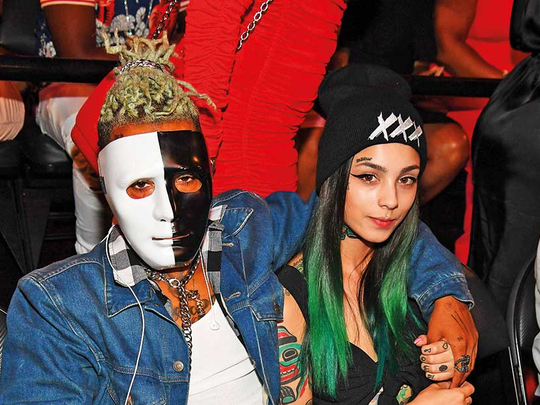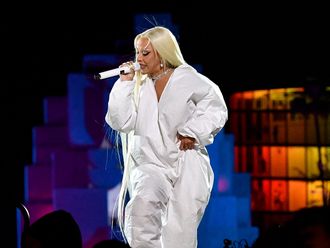
XXXTentacion lived a life of hyperfast, nihilistic violence where nothing could ever be put on pause. In the past year alone, he had a number one Billboard album, was banned from Spotify, dropped by his record label and charged with aggravated battery of a pregnant victim and witness tampering.
His ex-girlfriend detailed the most horrendous abuse in court documents and press interviews. He will be remembered mostly for the unusually cruel violence he exerted on vulnerable people, particularly his ex-girlfriend, crimes for which he never expressed remorse.
His music, a combination of hip hop and emo that was depressive, and at times devastating, reflected a life lived with disregard for humanity, both other people’s and his own. On Monday afternoon, he was shot and killed in Miami, during an armed robbery. He was 20 years old.
His life had many of the trappings of gangster rappers who were shot at a young age in the 1990s: drugs, violence and persistent trouble with the law. But XXXTentacion, real name Jahseh Dwayne Onfroy, was not exactly a hard man.
He was insecure and drug-addled, still living through his own traumatic childhood while he viciously abused others. His victims were not from rival gangs: they were women and strangers. His music rarely tried to demonstrate bravado or material gains, it mostly traced round mental illness, suicide, extreme misogyny and a prevailing feeling of numbness.
Onfroy, was born in Florida in 1998. His mother was financially unable, and at times just disinterested, in raising him, and he spent much of his childhood moving from home to home. The bond he had with her, he has repeatedly claimed, was incredibly strong. When she was in the picture he said she would shower him with gifts and affection. When she was away, a darkness and depression ate away at him, one that would define his short life.
Onfroy was constantly in trouble for violent behaviour, and was at one point expelled from school for beating up another student. By the time he was 17, he had already been charged with possession of a firearm, armed robbery, resisting arrest and Xanax possession. He had done two spells in juvenile detention and during the second one, violently beat a cell mate who he believed to be gay. According to an interview he gave in the Miami New Times, when his mother asked him what had happened he said: “This [expletive] did some gay [expletive], so I had to crack his head open.”
After he left juvenile prison, he began making music, mostly underground mixtapes with minor mainstream appeal. But in 2016 Onfroy’s profile started to rise thanks to the online success of his song Look At Me!, a track with violent lyrics that set the tone for that part of his career.
Onfroy was part of a new wave of artists, sometimes referred to as “Soundcloud Rap”, whose music embodied a disconnect with societal norms, and embraced internet culture and heavy Xanax use. The role of Xanax, an addictive and potent pharmaceutical used to treat anxiety, was important — it helped to soothe internal pain, and created a floating disconnect from reality. The other shining light of Soundcloud Rap, Lil Peep, who Onfroy mostly loathed, died in November of a Xanax overdose.
At the same time as his career was beginning to flourish, Onfroy entered into a relationship with a woman who he violently abused. According to court documents he variously stomped on her head, held her head strangled, kicked and punched her. He would also make repeated threats of suicide, often coming close to killing himself in front of her. Later, the woman became pregnant and Onfroy continued to brutally beat her and briefly kidnapped her. Onfroy was arrested for these crimes, as well as other charges and placed initially under house arrest and then in prison.
While in prison Onfroy, became troublingly famous. A$AP Rocky tweeted that he couldn’t wait for his release and some accused Drake of copying one of his verses. When Onfroy returned to house arrest while awaiting trial, he began recording. He worked with Diplo, among other big names and eventually released two albums, the second of which ? went to number one. It is a powerful record, performed in large parts on acoustic guitar, by a man desperately grasping to get something out of a life which he rightly senses might already coming to an end. He was lauded by giants of the genre including Kendrick Lamar. After his death Kayne West tweeted: “Never told you how much you inspired me when you were here thank you for existing.”
Some lump Onfroy in with the #MeToo movement, and his music is discussed in thinkpieces about whether you can ever separate the art from the artist. But the truth is that Onfroy’s crimes are so unspeakably violent, his hate for women so unchecked, that they form their own category. Unlike other artists, whose violence against women became known once they were already stars, it was Onfroy’s incarceration for domestic violence that helped create his celebrity.
In his final months, Onfroy was charged with witness tampering, and was accused of pressuring his ex-girlfriend to drop the charges against him. He made some attempts to rehabilitate his image, at one point claiming to donate $100,000 (Dh367,262) to a domestic violence charity — although it’s disputed whether he actually did. But the seriousness of his crimes he was accused of never seemed to register with him, and he would often return to violent language in the same breath as trying to clear his name.
Onfroy idolised Kurt Cobain, saying he was “the only person who inspires me”. Cobain is often said to be part of the “27 club” a group of people who lived hard and fast, only for their demons to catch up with them at a young age.
For Onfroy 27 would have been old age, his life contained so much trauma, inflicted and endured, that he barely made it out his teens.













